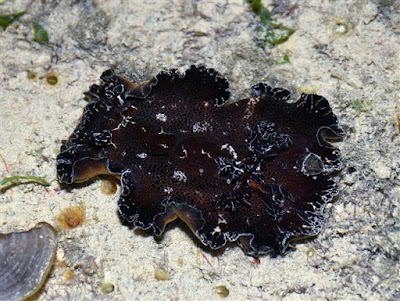I'm back at the sea fan garden of Changi after more than 2 years! How are the sea fans and the other marine critters doing on this shore?
Some of the Sea fans (Order Gorgonacea) are really huge and highly branched. Don't you think they really look like a fan? The sea fans are animals and not plants! Each fan is a colony of tiny polyps that produce a hard skeleton.
Here's a wider shot showing the numerous sea fans revealed when the tide went to its lowest. Otherwise, they are usually submerged and unseen as the visibility of its surrounding waters is low.
Taking a peek at the deeper ends, there are even more sea fans of all sorts of colours and forms!
The sea fans are fantastic home to many commensals such as this Winged oysters (Family Pteriidae).
Sometimes you may find Hermit crabs (Infraorder Anomura) clinging tightly to the sea fans. This shot of 3 hermit crabs is quite funny as they line up as if they are in the process of changing shells.
Another commensal sighted would be this Spindle cowrie snail (Family Ovulidae). These ovulids are carnivorous and prey on sea fans by biting off the polyps.
At the rocky and reefy areas are several of these Feather stars (Order Comatulida) that look really pretty when their arms extend out. My favourite is the black and white one on the top left corner of the collage.
Beneath or by the sides of rocks are some of the Sea toad spider crabs (Schizophrys sp.). They have long pointed heads and skinny legs and are masters of camouflage.
There was a special find of the Bohol nudibranch (Discodoris boholiensis)! We see these slugs more often in our Southern waters instead.
Another special find that made me go wow would be this huge and colourful Cake sea star (Anthenea aspera)! I have not seen this colour morph for the longest time. It really looks like a star-shaped cake with lots of colourful topping.
As compared to those found at the seagrass areas, the Biscuit sea stars (Goniodiscaster scaber) at the rocky areas are larger. This particular individual looks lovely with tinge of yellow and green.
Recently we have been seeing several of these Babylonia spirata snails. They only started appearing since last year. Looks like they are in season!
I was looking for the seahorses as they seem to have disappeared from our northern shores for some time. Instead, I saw the seagrass pipefishes which are relatives to the seahorses. They both belong to Family Syngnathidae. 'Syngnathus' means 'fused jaws' in Greek. Seahorses and pipefishes feed on tiny creatures by sucking them up with their tube-like, toothless snouts.
There was this stretch of substrate that is filled with tons of what looks like anemones. On a closer look, I realised these are juvenile Fan worms (Family Sabellidae)! First time seeing so many of them on Changi.
The tide came back before sunrise and we ended the survey with a lovely glow over the eastern horizon.
More photos of the trip on my facebook album:
https://www.facebook.com/media/set/?set=a.10153457951458158.1073741885.547198157&type=1&l=03a58597b2






















No comments:
Post a Comment